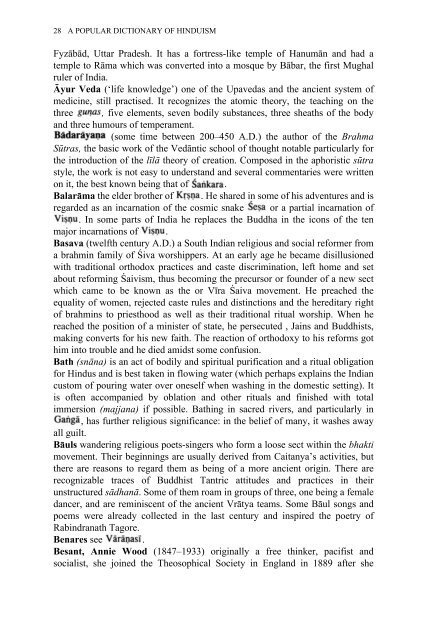You also want an ePaper? Increase the reach of your titles
YUMPU automatically turns print PDFs into web optimized ePapers that Google loves.
28 A POPULAR DICTIONARY OF HINDUISM<br />
Fyzābād, Uttar Pradesh. It has a fortress-like temple <strong>of</strong> Hanumān and had a<br />
temple to Rāma which was converted into a mosque by Bābar, the first Mughal<br />
ruler <strong>of</strong> India.<br />
Āyur Veda (‘life knowledge’) one <strong>of</strong> the Upavedas and the ancient system <strong>of</strong><br />
medicine, still practised. It recognizes the atomic theory, the teaching on the<br />
three , five elements, seven bodily substances, three sheaths <strong>of</strong> the body<br />
and three humours <strong>of</strong> temperament.<br />
(some time between 200–450 A.D.) the author <strong>of</strong> the Brahma<br />
Sūtras, the basic work <strong>of</strong> the Vedāntic school <strong>of</strong> thought notable particularly for<br />
the introduction <strong>of</strong> the līlā theory <strong>of</strong> creation. Composed in the aphoristic sūtra<br />
style, the work is not easy to understand and several commentaries were written<br />
on it, the best known being that <strong>of</strong> .<br />
Balarāma the elder brother <strong>of</strong> . He shared in some <strong>of</strong> his adventures and is<br />
regarded as an incarnation <strong>of</strong> the cosmic snake or a partial incarnation <strong>of</strong><br />
. In some parts <strong>of</strong> India he replaces the Buddha in the icons <strong>of</strong> the ten<br />
major incarnations <strong>of</strong> .<br />
Basava (twelfth century A.D.) a South Indian religious and social reformer from<br />
a brahmin family <strong>of</strong> Śiva worshippers. At an early age he became disillusioned<br />
with traditional orthodox practices and caste discrimination, left home and set<br />
about reforming Śaivism, thus becoming the precursor or founder <strong>of</strong> a new sect<br />
which came to be known as the or Vīra Śaiva movement. He preached the<br />
equality <strong>of</strong> women, rejected caste rules and distinctions and the hereditary right<br />
<strong>of</strong> brahmins to priesthood as well as their traditional ritual worship. When he<br />
reached the position <strong>of</strong> a minister <strong>of</strong> state, he persecuted , Jains and Buddhists,<br />
making converts for his new faith. The reaction <strong>of</strong> orthodoxy to his reforms got<br />
him into trouble and he died amidst some confusion.<br />
Bath (snāna) is an act <strong>of</strong> bodily and spiritual purification and a ritual obligation<br />
for Hindus and is best taken in flowing water (which perhaps explains the Indian<br />
custom <strong>of</strong> pouring water over oneself when washing in the domestic setting). It<br />
is <strong>of</strong>ten accompanied by oblation and other rituals and finished with total<br />
immersion (majjana) if possible. Bathing in sacred rivers, and particularly in<br />
, has further religious significance: in the belief <strong>of</strong> many, it washes away<br />
all guilt.<br />
Bāuls wandering religious poets-singers who form a loose sect within the bhakti<br />
movement. Their beginnings are usually derived from Caitanya’s activities, but<br />
there are reasons to regard them as being <strong>of</strong> a more ancient origin. There are<br />
recognizable traces <strong>of</strong> Buddhist Tantric attitudes and practices in their<br />
unstructured sādhanā. Some <strong>of</strong> them roam in groups <strong>of</strong> three, one being a female<br />
dancer, and are reminiscent <strong>of</strong> the ancient Vrātya teams. Some Bāul songs and<br />
poems were already collected in the last century and inspired the poetry <strong>of</strong><br />
Rabindranath Tagore.<br />
Benares see .<br />
Besant, Annie Wood (1847–1933) originally a free thinker, pacifist and<br />
socialist, she joined the Theosophical Society in England in 1889 after she


















